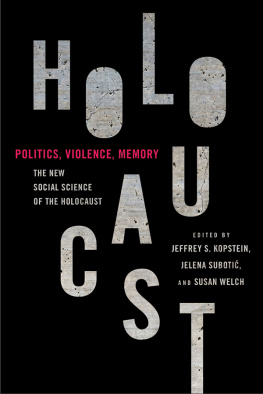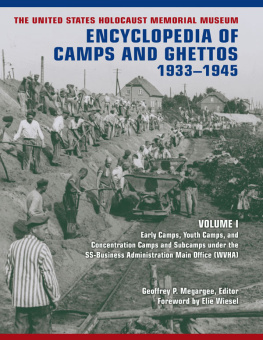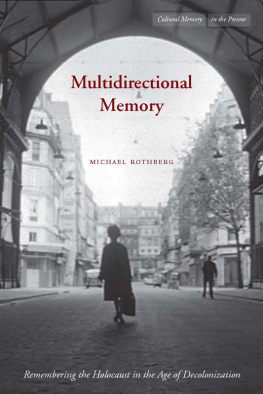Cover image by Beth Ponticello / Shutterstock.com
Published by State University of New York Press, Albany
2016 State University of New York
All rights reserved
Printed in the United States of America
No part of this book may be used or reproduced in any manner whatsoever without written permission. No part of this book may be stored in a retrieval system or transmitted in any form or by any means including electronic, electrostatic, magnetic tape, mechanical, photocopying, recording, or otherwise without the prior permission in writing of the publisher.
For information, contact State University of New York Press, Albany, NY
www.sunypress.edu
Production, Diane Ganeles
Marketing, Anne M. Valentine
Library of Congress Cataloging-in-Publication Data
Names: Bernard-Donals, Michael F.
Title: Figures of memory : the rhetoric of displacement at the United States Holocaust Memorial Museum / Michael Bernard-Donals.
Description: Albany : State University of New York Press, 2016. | Includes bibliographical references and index.
Identifiers: LCCN 2015024376| ISBN 9781438460772 (hardcover : alkaline paper) | ISBN 9781438460789 (e-book)
Subjects: LCSH: United States Holocaust Memorial Museum. | MemorySocial aspectsUnited States. | MemorialsSocial aspectsUnited States. | MemorialsUnited StatesPsychological aspects. | Displacement (Psychology)United States. | Rhetoric and psychology. | Museum visitorsWashington (D.C.)Psychology. | Museum exhibitsWashington (D.C.)Psychological aspects. | MuseumsSocial aspects. | MuseumsPsychological aspects.
Classification: LCC D804.175.W18 B47 2016 | DDC 940.53/18074753dc23 LC record available at http://lccn.loc.gov/2015024376
10 9 8 7 6 5 4 3 2 1
Acknowledgments
I was told, before I began this project, that toiling in the archives can be lonely work. And there were days of poking through boxes and papers when the labor took its toll. But most daysboth during the initial phase of the research in the suburbs surrounding Washington, D.C., and Baltimore, and afterward during the sorting, the writing, the rewriting, and rewriting some moreI was quite moved by the voices, real and virtual, that resonated in the spaces in which I was working. Those voices, and those individuals, made the work worth doing.
The United States Holocaust Memorial Museums institutional archives provide an incredibly rich site for research, but I could not have done any of it over many months in 2008 without the patience and generosity of Jeffrey Carter, the chief records officer at the museum. Jeffrey made the drive from his office in Washington to the archive in D.C. traffic to make sure the facility was open to me; he schlepped box after box, answered question after question, and kept me company with good conversation.
On my return, I had the good fortune to be appointed to a resident fellowship at the University of Wisconsin-Madisons Institute for Research in the Humanities. There I was fortunate to present and discuss my work in a rich intellectual community; Im particularly grateful to the senior fellows, to the institutes director, Susan Friedman, and to Teju Olaniyanalso my colleague in the English Departmentfor his exceptionally insightful questions and suggestions. The following year, as I was trying to make sense of what I had gleaned from the archives, the very talented Leah Misemer served as a project assistant and was not only a smart interlocutor during those months but also helped organize the material into categories that ultimately became the chapters youll see in the pages that follow.
There were two especially noteworthy opportunities for me to bring some of the preliminary results of my work to audiences who would work with it, turn it over, and rearticulate it in ways that made me see and understand the relation of archival and memorial spaces to memory in entirely new ways. In the fall of 2010, the graduate students in my seminar on spaces of memoryGinger Jurecka Blake, Will Broadway, Rachel Carrales, Chris Earle, Leigh Elion, Lewis Freedman, Mel Freitag, Nora Hansen, Lisa Hollenbach, Tim Johnson, Andy Karr, Laini Kavaloski, Victor Lenthe, Chris McVey, Elisabeth Miller, Doyin Ogunfeyimi, Antonio Tang, Becca Tarsa, Anne Wheeler, and Stephanie Whiteessentially helped me rewrite the project, and I am especially grateful to Scot Barnett, who helped me conceive the course in the first place. And at the Rhetoric Society of America Summer Institute in 2013, the participants in a workshop on rhetoric and memoryRisa Applegarth, Lindal Buchanan, Roseanne Carlo, Roberta Chevrette, Lisa Costello, Cynthia Fields, Jessica Harrell, Jennifer Juszkiewicz, Terese Monberg, Carroll Nardone, Marcy Orwig, KJ Rawson, Jessica Shumake, Ryan Skinnell, Glen Southergill, Connie Steele, and Justine Wellshelped me do it all over again through their own exceptionally smart projects.
The Department of English and the Mosse/Weinstein Center for Jewish Studies at the University of Wisconsin-Madison were wonderfully supportive of this project, and Im grateful to my colleaguesespecially Rachel Brenner, Mark Louden, Tony Michels, Doug Rosenberg, Jordan Rosenblum, Laurie Silverberg, and Kesha Weberfor providing such a congenial community in which to do this work. Im grateful to the Wisconsin Alumni Research Foundation, for recognizing my work by providing funding so that this project could come to fruition, and to the Office of the Provost, in which I now work, for its willingness to provide the time to complete this project and to continue my intellectual work while serving the university.
A number of colleagues have been generous with their time and support in any number of ways. They include Debbie Hawhee, Diane Davis, Jan Fernheimer, Kyle Jensen, Marianne Hirsch, Davida Charney, Lynn Worsham, Deborah Holdstein, Andrea Greenbaum, Steve Katz, and Patricia Bizzell. And finally, my childrenShoshana, Miryam, and Aviand Hannah, my wife, continue to help me keep a proper perspective on what truly matters.
A version of the second chapter of this book, , appeared in a slightly different form in College English 74.5 (May 2012) as Synecdochic Memory at the United States Holocaust Memorial Museum. Copyright 2012 by the National Council of Teachers of English. Reprinted with permission.
Introduction
Displacements of Memory at the
United States Holocaust Memorial Museum
S ince its construction more than twenty years ago, the United States Holocaust Memorial Museum has become one of the most visited sites in the US capital, and one of the worlds leading institutions dedicated to the preservation of Holocaust memory and the documents and artifacts that serve as its touchstones. The massive building, designed by James Ingo Freed to resemble the architecture of the camps, moves visitors from a large common space on the museums first floor, up an elevator to the permanent exhibition beginning on the museums fourth floor, which follows, chronologically, the history of the destruction of Europes Jews through the third and second floors of the museum. The visitor then walks down a large staircase to the main floor, which is constantly crowded with people waiting their turns for the elevators to begin their visit as well as those who have just completed their traversal of the museums space. These visitors are drawn from all over the United States and around the world. Many are members of tour groups organized by churches, schools, senior centers, and other organizations. Some have a rudimentary understanding of the events of the Holocaust, while others are learning about it at the museum for the very first time. Learning about the Holocaust was very much the raison dtre of the museum, and members of the United States Holocaust Council, charged with creating a memorial to the Holocaust on American soil, wanted to ensure that no one entering the museum could leave without remembering what had happened to the Jews of Europe and to ensure that nothing like it could happen again.










